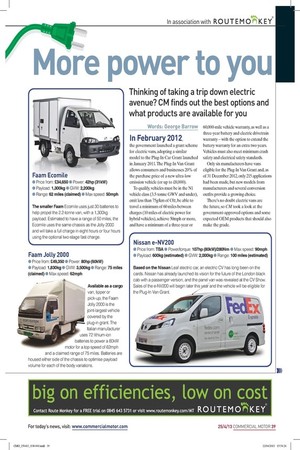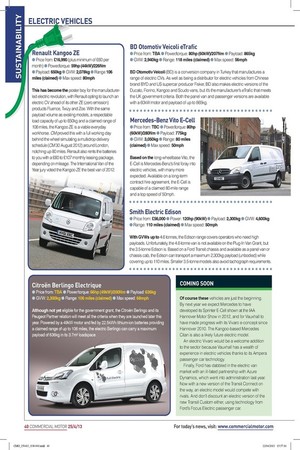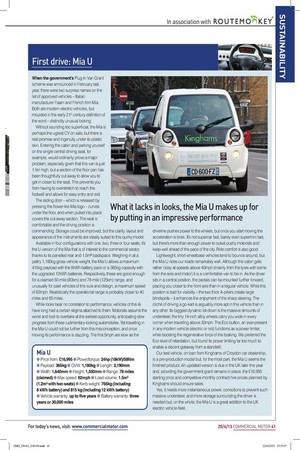More power to you Thinking of taking a trip down
Page 30

Page 31

Page 32

If you've noticed an error in this article please click here to report it so we can fix it.
electric avenue? CM finds out the best options and what products are available for you Virgil lib: l7C1J1 9 Ddl I OW In February 2012, the government launched a grant scheme for electric vans, adopting a similar model to the Plug-In Car Grant launched in January 2011. The Plug-In Van Grant allows consumers and businesses 20% of the purchase price of a new ultra-low emission vehicle (or up to £8,000).
To qualify, vehicles must be in the Ni vehicle class (3.5-tonne GWV and under), emit less than 75g/km of CO2, be able to travel a minimum of 60 miles between charges (10 miles of electric power for hybrid vehicles), achieve 50mph or more, and have a minimum of a three-year or 60,000-mile vehicle warranty, as well as a three-year battery and electric drivetrain warranty — with the option to extend the battery warranty for an extra two years. Vehicles must also meet minimum crash safety and electrical safety standards.
Only six manufacturers have vans eligible for the Plug-In Van Grant and, as of 31 December 2012, only 215 applications had been made, but new models from manufacturers and several conversion outfits provide a growing choice.
There's no doubt electric vans are the future, so CM took a look at the government-approved options and some expected OEM products that should also make the grade. Faam Ecomile • Price from: £34,650 • Power: 42hp (31kW) • Payload: 1,300kg • GVW: 2,200kg • Range: 62 miles (claimed) • Max speed: 50mph The smaller Faam Ecomile uses just 30 batteries to help propel the 2.2-tonne van, with a 1,300kg payload. Estimated to have a range of 50 miles, the Ecomile uses the same chassis as the Jolly 2000 and will take a full charge in eight hours or four hours using the optional two-stage fast charge.
Faam Jolly 2000 • Price from: £49,350 • Power: 80hp (60kW) • Payload: 1,830kg • GVW: 3,500kg • Range: 75 miles (claimed) Max speed: 62mph _a— Available as a cargo van, tipper or pick-up, the Faam Jolly 2000 is the joint-largest vehicle covered by the plug-in grant. The Italian manufacturer uses 72 lithium-ion batteries to power a 60kW motor for a top speed of 62mph and a claimed range of 75 miles. Batteries are housed either side of the chassis to optimise payload volume for each of the body variations. ecars europe Nissan e-NV200 Price from: TBA Power/torque: 107hp (80kW)I280Nm _ Max speed: 90mph • Payload: 600kg (estimated) • GVW: 2,000kg Range: 100 miles (estimated) Based on the Nissan Leaf electric car, an electric CV has long been on the cards. Nissan has already launched its vision for the future of the London black cab with a passenger version, and the panel van was revealed at the CV Show. Sales of the e-NV200 will begin later thisyeand the vehicle will be eligible for the Plug-In Van Grant. Renault Kangoo ZE • Price from: £16,990 (plus minimum of £60 per month) • Power/torque: 59hp (44kW)226Nm IF' Payload: 650kg • GVVV: 2,078kg Range 106 miles (claimed) • Max speed: 80mph This has become the poster boy for the manufacturerled electric revolution, with Renault opting to launch an electric CV ahead of its other ZE (zero emission) products Fluence, Twizy and Zoe. With the same payload volume as existing models, a respectable load capacity of up to 650kg and a claimed range of 106 miles, the Kangoo ZE is a viable everyday workhorse. CM proved this with a full working day behind the wheel simulating a multidrop delivery schedule (CM30 August 2012) around London, notching up 80 miles. Renault also rents the batteries to you with a £60 to £107 monthly leasing package, depending on mileage. The International Van of the Year jury voted the Kangoo ZE the best van of 2012. 1 BD Otomotiv Veicoli eTrafic • Price from: TBA • Power/torque: 80hp (60kW)I207Nm • Payload: 865kg • GVVV: 2,940kg • Range: 118 miles (claimed) • Max speed: 56mph BD OtomotivVeicoli (BD) is a conversion company in Turkey that manufactures a range of electric CVs. As well as being a distributor for electric vehicles from Chinese brand BYD and US supercar producer Fisker, BD also makes electric versions of the Ducato, Fiorino, Kangoo and Scudo vans, but it's the manufacturer's eTrafic that meets the UK government criteria. Both the panel van and passenger versions are available with a 60kW motor and payload of up to 865kg.
Mercedes-Benz Vito E-Cell • Price from: TBC • Power/torque: 80hp (60kW)I280Nm • Payload: 775kg • GVVV: 3,050kg • Range: 80 miles (claimed) • Max speed: 50mph Based on the long-wheelbase Vito, the E-Cell is Mercedes-Benz's first foray into electric vehicles, with many more expected. Available on a long-term contract hire agreement, the E-Cell is capable of a claimed 80-mile range and a top speed of 50mph.
Smith Electric Edison • Price from: 06,000 • Power: 120hp (90kW) • Payload: 2,300kg GVW: 4,600kg • Range: 110 miles (claimed) • Max speed: 50mph With GVWs up to 4.6 tonnes, the Edison range covers operators who need high payloads. Unfortunately, the 4.6-tonne van is not available on the Plug-In Van Grant, but the 3.5-tonne Edison is. Based on a Ford Transit chassis and available as a panel van or chassis cab, the Edison can transport a maximum 2,300kg payload (unbodied) while covering up to 110 miles. Smaller 3.5-tonne models also avoid tachograph requirements.
• • • • • • • • • • • • • • • • • • • • • • • • • • • • • • • • • • • • • • • Citroen Berlingo Electrique • Price from: TBA Power/torque: 66hp (49kW)I200Nm • Payload: 636kg • GVW: 2,300kg • Range: 106 miles (claimed) • Max speed: 68mph Although not yet eligible for the government grant, the Citroen Berlingo and its Peugeot Partner relation will meet all the criteria when they are launched later this year. Powered by a 49kW motor and fed by 22.5kWh lithium-ion batteries providing a claimed range of up to 106 miles, the electric Berlingo can carry a maximum payload of 636kg in its 3.7m3 loadspace. Of course these vehicles are just the beginning. By next year we expect Mercedes to have developed its Sprinter E-Cell shown at the IAA Hannover Motor Show in 2012, and for Vauxhall to have made progress with its Vivaro e-concept since Hannover 2010. The Kangoo-based Mercedes Citan is also a likely future electric model.
An electric Vivaro would be a welcome addition to the sector because Vauxhall has a wealth of experience in electric vehicles thanks to its Ampera passenger car technology.
Finally, Ford has dabbled in the electric van market with an ill-fated partnership with Azure Dynamics, which went into administration last year. Now with a new version of the Transit Connect on the way, an electric model would compete with rivals. And don't discount an electric version of the new Transit Custom either, using technology from Ford's Focus Electric passenger car. First drive: Mia U When the government's Plug-In Van Grant scheme was announced in February last year, there were two surprise names on the list of approved vehicles — Italian manufacturer Faam and French firm Mia. Both are modern electric vehicles, but moulded in the early 21st century definition of the word — distinctly unusual looking.
Without sounding too superficial, the Mia is perhaps the ugliest CV on sale; but there is real promise and ingenuity under its plastic skin. Entering the cabin and parking yourself on the single central driving seat, for example, would ordinarily prove a major problem, especially given that this van is just 1.5m high, but a section of the floor pan has been thoughtfully cut away to allow you to get in closer to the seat. This prevents you from having to overstretch to reach the footwell and allows for easy entry and exit.
The sliding door—which is released by pressing the flower-like Mia logo — curves under the floor, and when pulled into place covers the cut-away section. The seat is comfortable and the driving position is commanding. Storage could be improved, but the clarity, layout and appearance of the instruments are ideally suited to this quirky model.
Available in four configurations with one, two, three or four seats, it's the U version of the Mia that is of interest to the commercial sector, thanks to its panelled rear and 1.5m3 loadspace. Weighing in at a paltry 1,180kg gross vehicle weight, the Mia U allows a maximum 415kg payload with the 8kWh battery pack or a 365kg capacity with the upgraded 12kWh batteries. Respectively, these are good enough for a claimed 50-mile (80km) and 78-mile (125km) range, and unusually for past vehicles of this size and design, a maximum speed of 62mph. Realistically the operational range is probably closer to 40 miles and 65 miles.
While looks bear no correlation to performance, vehicles of this ilk have long had a certain stigma attached to them. Motorists assume the worst and look to overtake at the earliest opportunity, anticipating slow progress from these rudimentary-looking automobiles. Yet travelling in the Mia U could not be further from this misconception, and once moving its performance is dazzling. The first 5mph are slow as the driveline pushes power to the wheels, but once you start moving the acceleration is brisk. It's not supercar fast, barely even supermini fast, but there's more than enough power to outwit pushy motorists and keep well ahead of the pace of the city. Ride comfort is also good.
Lightweight, short-wheelbase vehicles tend to bounce around, but the Mia U rides our roads remarkably well. Although the cabin gets rather noisy at speeds above 40mph (mainly from the tyres with some from the axle and motor) it is a comfortable van to be in. As the driver sits in a central position, the pedals can be mounted further forward, placing you closer to the front axle than in a regular vehicle. While this position is bad for visibility — the two thick A-pillars create large blindspots — it enhances the enjoyment of the sharp steering. The cliché of driving a go-kart is arguably more apt in this vehicle than in any other. Its biggest dynamic let down is the massive amounts of understeer, the tiny 14-inch alloy wheels carry you wide in every corner when travelling above 30mph. The Eco button, an ever-present in any modern vehicle (electric or not) functions as a power limiter, while boosting the regenerative force of the braking. We preferred the Eco level of retardation, but found its power limiting far too much to enable a decent getaway from a standstill.
Our test vehicle, on loan from Kinghams of Croydon car dealership, is a pre-production model but, for the most part, the Mia U seems the finished product. An updated version is due in the UK later this year and, providing the government grant remains in place, the £16,995 starting price and competitive monthly contract hire prices planned by Kinghams should ensure sales.
Yes, it needs more instantaneous power, corrections to prevent such massive understeer, and more storage surrounding the driver is needed but, on the whole, the Mia U is a great addition to the UK electric vehicle fleet. Mia U w Price from: £16,995 • Power/torque: 24hp (18kWy58Nm • Payload: 365kg • GVW: 1,180kg • Length: 3,190mm Width: 1,640mm • Height: 1,550mm • Range: 78 miles (claimed) • Max speed: 62mph • Load volume: 1.5m3 (1.2m3with two seats) • Kerb weight: 765kg (including 8 kWh battery) and 815 kg (including 12 kWh battery) Vehicle warranty: up to five years • Battery warranty: three years or 30,000 miles







































